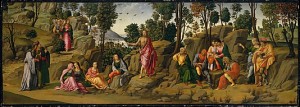Pinky Says: AND YET ANOTHER MICHELANGELO ARRIVES?
Get ready for another miraculous discovery in the field of art. The Metropolitan Museum of New York is in the process of identifying a work which they acquired in 1970 as a work by Michelangelo. That does not mean that the identity of the painter has been firmly established. And in this case it provides a clear timeline for determining the authorship of all “found art”. Here is a painting that has resided in the museum for over 40 years attributed to Francesco Granacci, who just happened to be a good friend of Michelangelo. Now comes Everett Fahy, one of the world’s most distinguished scholars of the Italian Renaissance, and declares that SAINT JOHN THE BAPTIST BEARING WITNESS is not a Granacci but is absolutely the work of Michelangelo. Fahy says, “I’m acutely aware that Michelangelo attracts a lot of crazy ideas, and people are going to say this is another absurd idea…….I’m expecting that they’re going to throw brickbats.”
Fahy has just recently retired as chairman of the Met’s department of European paintings. His successor is Keith Christiansen who has gone on record saying, “I think Everett has put forward the strongest argument that can be made for it.” Now Mr. Christiansen, does this mean you agree yes or disagree no? To which he smiles and says “I don’t do yes or no.” Fahy has shown the work to authorities in the field beginning with the late Edmund P. Pillsbury who was completely convinced that the work was by Michelangelo. Fahy says that it is to be expected that others will disagree, but “the people who really have good eyes in this field that he has shown the painting all agreed with me.” He has written a 65 page article about the painting which he has titled “An Overlooked Michelangelo?” He used the question mark because it wold be more diplomatic and not offend people who might still be dubious about the bona fide painter of the work. Christiansen, in turn, states that the attribution will not be changing because he thinks a public institution should reflect a consensus view of the outstanding scholars of the period. But he estimates the it will take a whole generation to definitely approve of the authorship of Michelangelo. He continued,”It’s terrific that Everett has the courage to put himself out, but he’s going to be raked over the coals.”
The Met bought the painting at Sotheby’s London together with a companion work attributed to Granacci; both works concern the life of the Baptist. It is interesting that the Met paid $50,000 more for the Granacci which is still a Granacci than they did for the possible Michelangelo. (The possible Michelangelo will herein after be identified as simply the second panel.) Fahy feels that the the second panel is so superior to the companion panel and he believes that Michelangelo painted it in 1506, only two years before he began work on the Sistine ceiling. Michelangelo was five years younger than Granacci who played a formative role in the younger man’s early life. They were extremely close and Granacci looked after his friend’s personal affairs when Michelangelo was out of town.
Fahy feels that the second panel is so superior to the companion panel. The Granacci painting depicts seven scenes from the story of St. John the Baptist set in a classical pavillion with a grayed blue river in the background. It is an oil, tempera, and gold on walnut panel and is dated circa 1510. The second panel contains a single episode in a stony setting and is executed only in oil and gold on wood. It would seem that the pairing of the two panels as companion pieces might be doubtful. Both panels were attributed to Ghirlandaio. The first recorded owner was Samuel Woodburn who was described as the most eminent dealer in works of art in England. At some point the works entered the collection of the earl of Ashburnham. The attribution of scenes from the life of John the Baptist was recognized as a work by Granacci and this is universally accepted today. It is evident to the naked eye that the two panels were by different artists because the handling of the paint, the design of the figures, and the rendering of the landscapes are completely different. Three different artists have been the proposed painter of this second panel. One of the three proposals suggest that the panel was painted by an assistant to Granacci using Michelangelo’s drawings. Fahy finds striking analogies between Michelangelo’s full frontal nude drawings and the painting. He finds nude male figures in the middle ground of the Doni Tondo who have the same poses as some of the figures on the second panel. We know that Michelangelo was in Florence most of the year in 1506 after completing the tomb of Julius II in Rome. His most important patron was Giovanni (or John) and he was intimately involved with Michelangelo, who had been stuck up to that time in Carrara or Bologna doing the portrait of Julius or working on the tomb. The style of the panel coincides with the work of Michelangelo in this period.
A sculpture now on view in the Met is one attributed to Michelangelo. It had been housed in he lobby of a town House on 5th Avenue as a decorative object. My tenuous connection with Michelangelo attributions is that I wen to undergraduate school with Professor Irving Lavin who made the first discovery of the sculpture in 1996. Lavin is convinced that it is a Michelangelo sculpture and so is Fahy . Both Fahy and James Draper, curator of European Sculpture at the Met, are convinced it is a work by Michelangelo. However other scholars disagree. Now 15 years later there is still no change in attribution. Fahy is a brilliant art historian in my book. As a young man he was often called the Baby BB (Bernard Berenson the legendary historian of the Italian Renaissance). LastLavin year he opted for early retirement because the Met has been facing the problem of having to fire young staff to cut operating expenses. In so doing he probably protected the jobs of at least 3 or 4 younger historians. My tenuous connection with Michelangelo attributions is that I went to undergraduate school with Professor Irving Lavin who is now retired from NYU Institute of Fine Art but made the first discovery of the sculpture in 1996. This sculpture is still under investigation for a Michelangelo attribution. It will be interesting to see what transpires as the Renaissance scholars begin their further investigations. Until that time Fahy has the inside track on the second panel. The truth of the matter is that by the time the final decision is made most of the participants in the judgment may well have expired, but if the second panel does meet with the approval of the scholars it will be a feather in the cap or the Met and Everett Fahy. The world of masterpiece accreditation is a maze and the decision to verify a work is tedious and confounding. It just takes a lot of time to be able to remove the question mark. The concept that Rome was not built in a day applies to any changes to attributions for any and all works of art of the High Renaissance. But when and if this second panel is accepted it will increase the value and quality of the Met holdings geometrically. So on with the testing and critiquing of the Granacci that may be a Michelangelo.



Leave a Reply